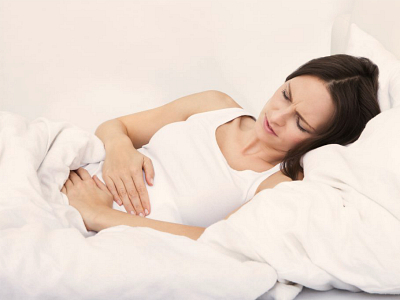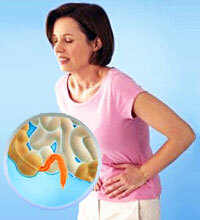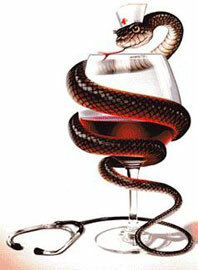1 Characteristic symptoms of appendicitis
It is necessary to know that this acute inflammatory process develops in different ways. Everything depends on age, the presence of concomitant pathologies, the state of the immune system, and the localization of the appendix.
Do you have gastritis?
GALINA SAVINA: "How to just cure gastritis at home for 1 month. The proven method - write down the recipe. ..!"Read more & gt; & gt;
In most patients appendicitis can begin with the appearance of the following symptoms.
- Pain is a characteristic sign of inflammatory processes in the abdominal cavity. It appears spontaneously, localized in the navel or midline of the abdomen, eventually passes into the region of the right hypochondrium. In the early stages, the pain syndrome is poorly expressed, after several hours the unpleasant sensations become worse.
- The general condition of the organism worsens: the patient loses his appetite, his sleep is disturbed. The temperature with appendicitis rises to 38 degrees, the heart rate increases to 80 beats per minute. In some cases, febrile syndrome may develop. Constant nausea is accompanied by repeated attacks of vomiting, the tongue is densely covered with a light coating. Unpleasant sensations in the right side become worse, if the patient is lying on the left. Therefore, for acute appendicitis is characterized by a person's stay, lying on his right side.
Acute inflammation of the appendix in a child older than 7 years can begin just like in adults. In children younger than 5 years, it begins sharply and is characterized by rapid development. The disease can manifest itself in the form of restless behavior, refusal of food, sleep disturbances, fever up to 40 degrees, pronounced febrile syndrome. At moments of reduced intensity of symptoms, the child tries to stay in one position, without making any movements.
In children older than 5 years, acute appendicitis can be suspected when the following symptoms appear:
- abdominal pains, often changing their localization;
- restless behavior( whims, loss of appetite, insomnia);
- sudden temperature increase;
- syndrome of toxic scissors( increased heart rate as the temperature rises).

It is recommended to read
- Symptoms of appendicitis in men
- Signs of appendicitis
- In which side appendicitis
- Effective remedy for gastritis and stomach ulcer
Acute appendicitis almost always leads to digestion, which can manifest as diarrhea, vomiting or constipation. Young children have pain when urinating.
2 Clinical picture of appendicitis depending on its stage
The disease is characterized by a progressive developmental character, the symptomatology largely depends on the degree of inflammation of the appendix. The early stage lasts for 12 hours from the onset of the illness. Its main feature is abdominal pain, which intensifies in the evening, during movements and coughing. There is a nausea, often ending with a fit of vomiting. The temperature rises to 38 degrees.
-
 IMPORTANT TO KNOW! Gastritis? Ulcer? To have a stomach ulcer not turned into cancer, drink a glass. ..Read the article & gt; & gt;
IMPORTANT TO KNOW! Gastritis? Ulcer? To have a stomach ulcer not turned into cancer, drink a glass. ..Read the article & gt; & gt;

In the next stage, appendicitis takes a purulent phlegmonous form. Pain passes to the right lower abdomen. Tachycardia is noted, the temperature is kept at the same level. The muscles of the abdominal press tighten, with palpation the doctor immediately reveals all the signs of inflammation of the appendix.
Gangrenous stage develops on the second-third day of the disease. The pain syndrome becomes less intense, which is associated with necrosis of the nerve endings of the affected area. There are pronounced symptoms of intoxication of the body - rapid heartbeat, nausea, dryness of the mucous membranes. The chair is absent, the abdomen sharply swells.
The last stage of acute appendicitis is perforating. Violation of the integrity of the appendix is accompanied by acute pain, the intensity of which is constantly increasing. Vomiting takes a stubborn character, the stomach swells, there is no stool, and the temperature overcomes the 40 degree mark.
-
 Gastroenterologist. IMPORTANT: "I beg you, if you started to worry about abdominal pain, heartburn, nausea, do not do gas in any way. .."Read more & gt; & gt;
Gastroenterologist. IMPORTANT: "I beg you, if you started to worry about abdominal pain, heartburn, nausea, do not do gas in any way. .."Read more & gt; & gt;

3 Atypical forms of appendicitis
The development of these types of disease is associated with an abnormal structure of the appendix. This significantly complicates the identification of acute appendicitis, which increases the risk of its transition to neglected forms. Retrocecal type of pathology is found in 10% of cases. The pain in this case is localized in the right hypochondrium, they irradiate into the right leg and back. Nausea and vomiting are absent. The liquid stool contains mucous inclusions. The temperature rises already in the first day of illness.

Pelvic appendicitis is found most often in women. The pains are localized in the lower abdomen, they are given to the inguinal region and the navel. With this form of the disease, there are frequent urge to urinate and diarrhea. The temperature does not increase, signs of poisoning of the body are poorly expressed.
With medial appendicitis there is a pronounced clinical picture - cutting pains in the navel, chills, repeated attacks of vomiting, tension of the abdominal muscles, intestinal obstruction.
With chronic appendicitis, attacks of pain are temporary. During the exacerbation, there are pronounced signs of an acute form of the disease.
Pain and heaviness in the right side are typical symptoms of inflammation. They may differ in localization, severity and character( aching, acute, paroxysmal).
ADVICE FROM THE MAIN GASTROENTEROLOGIST
Korotov SV: "I can recommend only one remedy for the rapid treatment of Ulcer and Gastritis, which is now recommended by the Ministry of Health. .." Read testimonials & gt; & gt;
Classic appendicitis begins with the onset of severe pain that spreads all over the stomach. It then subsides, then intensifies, but its complete disappearance is extremely rare. Reduction of the intensity of unpleasant sensations on day 3 of the disease indicates its transition to a gangrenous form. A sharp attack of pain is observed with a rupture of the appendix and the development of peritonitis.
Pain in appendicitis can appear in the navel at the first stage, in the lower abdomen - with classical catarrhal inflammation, in the waist - with retrocalcis and above the pubis - with the pelvic.

When diagnosing a disease, the doctor should pay special attention to body temperature. In the first 12 hours it is kept within the subfebrile values. As the disease develops, it rises to 38 degrees, with a gangrenous form marked by a sharp drop in temperature. Its rise to 40 degrees is a sign of a beginning peritonitis.
The temperature does not always correspond to the severity of the inflammatory process. The pronounced febrile syndrome at an early stage develops mainly in young children. In severe purulent forms, the temperature is constantly changing.
WE RECOMMEND!
For prevention and treatment of Digestive Diseases our readers advise Monastic tea. This unique remedy consists of 9 medicinal herbs useful for digestion, which not only supplement, but also strengthen each other's actions. Monastic tea will not only eliminate all symptoms of the gastrointestinal tract and digestive system, but will also permanently eliminate the cause of its occurrence.
Opinion of doctors. .. "
4 Diagnostic signs of acute appendicitis
As the clinical picture of the disease differs in its variety of manifestations, it is impossible to diagnose independently. The diagnosis of the disease begins with a patient's examination of the patient and an anamnesis. Then the general analysis of blood and urine, ultrasound of the abdominal cavity or diagnostic laparoscopy is prescribed.
There are also ways to detect appendicitis at home, allowing timely delivery of the patient to a medical institution. Use them with caution, trying not to provoke a new attack of pain.
When you tap the fingers in the right iliac region, discomfort appears, while there are no unpleasant sensations from the opposite side of the abdomen. Pain that subside when the patient lies on his right side indicates the presence of acute appendicitis. Unpleasant sensations become sharper when sneezing and coughing. With your palm, press down on the sore spot, holding it for a few seconds. If the pain increases after the removal of the hand, it is necessary to take the patient to the hospital.
- 1 Characteristic symptoms of appendicitis
- 2 Clinical picture of appendicitis depending on its stage
- 3 Atypical Appendicitis
- 4 Diagnostic signs of acute appendicitis
How does appendicitis manifest? Inflammation of the appendix of the cecum has a rather pronounced clinical picture. Signs of this pathology are known to many, however appendicitis develops in different stages with characteristic features. How to identify it and prevent the development of dangerous consequences?



